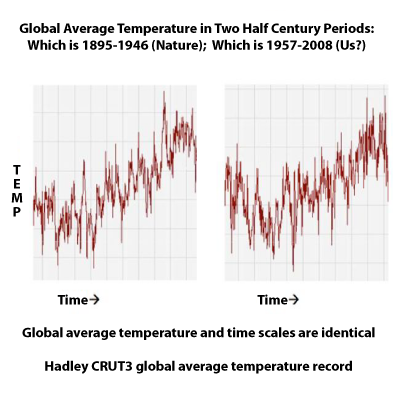On September 27, the UN IPCC released its Summary for Policy Makers as the first part of its Fifth Assessment Report on climate change. The IPCC was hard pressed to explain away the lack of warming for the past 15 years, even though carbon dioxide emissions have been rising. None of the climate models predicted or can explain the pause, and none can explain the increasing Antarctic sea ice. The IPCC argument boils down to “the oceans ate my global warming.” Climate is complex and the models just can’t get all the parameters right. Their major stumbling block is the assumed value of carbon dioxide forcing.
In spite of model failures, the IPCC is now 95% confident that human carbon dioxide emissions are responsible for the majority of global warming since 1950. The lack of any physical evidence to support that contention does not deter them, because the IPCC report is a political document rather than a scientific one. Much government policy (and money) depends on maintaining the myth of dangerous, human-caused global warming.
The 20th Century had two warming phases: about 1900-1946 and 1957-2008. The IPCC claims that the first one was all natural, but the second one was due principally to carbon dioxide emissions. Anthony Watts, proprietor of WUWT blog, has devised a little quiz. Below are two graphs of temperatures, one from 1895 to 1946 when warming was due to Nature with little or no influence from carbon dioxide, versus a graph from 1957 to 2008 when warming was supposedly due to human carbon dioxide emissions according to the IPCC. Can you tell which is which? Both graphs have the same vertical and horizontal scales. (Answer at the end of this post.)
Both graphs are remarkably similar. How can you pick an anthropogenic signal from one and not the other? Did nature stop working in 1950?
Dr. Richard Lindzen, emeritus Alfred P. Sloan Professor of Meteorology, Department of Earth, Atmospheric and Planetary Sciences at MIT, had this to say about the IPCC report:
I think that the latest IPCC report has truly sunk to a level of hilarious incoherence. They are proclaiming increased confidence in their models as the discrepancies between their models and observations increase.
Their excuse for the absence of warming over the past 17 years is that the heat is hiding in the deep ocean. However, this is simply an admission that the models fail to simulate the exchanges of heat between the surface layers and the deeper oceans. However, it is this heat transport that plays a major role in natural internal variability of climate, and the IPCC assertions that observed warming can be attributed to man depend crucially on their assertion that these models accurately simulate natural internal variability. Thus, they now, somewhat obscurely, admit that their crucial assumption was totally unjustified.
Finally, in attributing warming to man, they fail to point out that the warming has been small, and totally consistent with there being nothing to be alarmed about. It is quite amazing to see the contortions the IPCC has to go through in order to keep the international climate agenda going.
For the real story on climate science, I recommend the recently published report: Climate Change Reconsidered II (CCR-II). This is an independent, comprehensive, and authoritative report on the current state of climate science produced by the Non-governmental International Panel on Climate Change (NIPCC), an international network of climate scientists sponsored by three nonprofit organizations: the Science and Environmental Policy Project, Center for the Study of Carbon Dioxide and Global Change, and The Heartland Institute.
CCR-II cites more than 1,000 peer-reviewed scientific papers to show that the IPCC has ignored or misinterpreted much of the research that challenges the need for carbon dioxide controls. In other words, the NIPCC report demonstrates that the science being relied upon by governments to create multi-billion dollar policies is almost certainly wrong. NIPCC’s basic conclusion is that the greenhouse gas-induced global climate signal is so small as to be embedded within the background noise variability of the natural climate system and is not dangerous.
You can download the reports from these links:
CCR-II Physical Science full report (20Mb, 1,018 pages)
CCR-II Summary for Policy Makers (2.7Mb, 22 pages)
CCR-II Executive Summary 5 pages.
I strongly recommend you read the Summary for Policy Makers and the Executive Summary.
Quiz answer: The graph on the left above is the more recent period. You can see the super El Nino spike of 1998.
I will examine the issue of ocean heat in part 2.
See also:
Climate change in perspective, my summary of the major climate issues.

